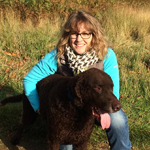Over the last few years, I have been really privileged to work with a number of different dog patients, especially older dogs, all with different physical challenges.
I really enjoy watching the transformation in my patients, seeing a dog with joint pain, being stiff and struggling to move; to then relaxing into the massage treatment and gaining increased flexibility. My patients genuinely seem to enjoy our massage sessions.
In many cases, the dogs get a renewed energy and interest in life. With this in mind, I wanted to share a case study with you about one of my clients, Dennis. Dennis is a 16yr old Jack Russell and in the last few years has suffered from stiffness in both his hind legs. Dennis has also had a few bleeds on the brain which has affected the way he now holds his head, always tilted to one side, which has resulted in him slowing down a bit in his (very) old age.
After a series of canine massage treatments, Dennis’ owner has noticed a real transformation in him and has said to me “Just thought I’d let you know that Dennis is particularly good physically following his session with you. He’s been going down the steps to the garden and he’s also managing the few stairs inside a lot better. His back legs are more coordinated and seem stronger. His walks have been good – he’s wanting to go further and has more energy.”
It has been a pleasure to watch Dennis transform from a dog who is struggling to move; to one that has better posture, and a renewed energy in life.
So how did canine massage help Dennis with his joint pain?
- Massage helps to ease some of the pain associated with age-related arthritis by relaxing tight muscles to enable greater mobility.
- By then relaxing tight muscles and improving mobility the older dog is more likely to want to move around a bit more, go on short walks or even trot about. Inaction impairs the healing process and tired/tight muscles cannot naturally repair themselves. When a muscle contracts then relaxes, fresh oxygenated blood is pushed through the muscle fibers, thus promoting healing.
- Massage can also help to reduce the compensatory pain associated with imbalanced muscle use.
- Immobility can lead to a build-up of toxins, which are only released upon movement. Massage helps to remove toxins from the venous circulation and lymphatic system by replicating the movement of muscles, this is why we see an increase in energy levels in patients such as Dennis.
- Massage also helps release endorphins, which are the body’s natural painkillers, helping the dog to relax and enjoy a rejuvenating sleep – also enabling the body to heal itself.
What else can we do to help our older dogs?
Aside from canine massage, we can also make small adjustments around the house to help our older dogs. Here are few simple ideas:
- Avoid slippery surfaces. Wooden floors or tiles can make it difficult for a dog with joint pain to maintain their balance, and this can be heightened with an older dog. Perhaps put down a safe surface such as non-slip rugs along the main traffic routes throughout your home. Dennis’ owner invested in anti-slip flooring throughout her house to help him get about comfortably.
- Minimise access to stairs. Going up and down stairs can be physically very demanding for older dogs. Try to avoid access to them or help them by supporting them up and down stairs. Dennis’ owner further invested in anti-slip decking with wide, shallow steps leading down to the garden.
- Raise their eating and drinking bowls. This sounds like a simple thing to do but just propping your dogs bowl up on a couple of bricks means they won’t need to bend down so far to get their supper, thus reducing the pressure on their joints.
If your dog is struggling, as Dennis has, with movement, regardless of age, why not get in touch with your local, qualified canine massage therapist –they could help to put the spring back in your dog’s step.
Sources:
https://www.caninearthritis.co.uk/
https://holisticvet.co.za/living-with-arthritis-how-can-you-help-make-your-pets-life-a-little-easier/
 Jacqueline Newholm
Jacqueline Newholm
Big Brown Dog Therapy is an alternative natural therapy to help dogs to stay healthier, fitter and stronger for longer. For Ms. Newholm, the discovery of canine massage came about in 2008 when Tabasco, an exuberant puppy inspired her to study canine psychology and then massage. As a practicing canine massage therapist since January 2015, and a passionate dog owner she then set up Big Brown Dog Canine Massage Therapy in September 2016 to offer dog owners an alternative therapy to traditional medicine. Canine massage can be an effective tool to help reduce the pain, discomfort and stress associated with damaged or injured muscle, repetitive strain and the effects of chronic orthopaedic conditions.
Jacqueline is a member of the International Association of Animal Therapists (IAAT) and is required to maintain and enhance her skill base by continuing to learn (CPD). Big Brown Dog Canine Massage Therapy acknowledges and respects the Veterinary Surgeons Act 1966 and Exemption Order 1962 by never working upon an animal without gaining prior veterinary approval.
To discover more please visit: https://www.bigbrowndogtherapy.co.uk







